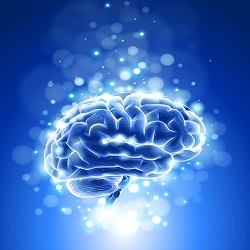The myth that humans use only 10% of their brain capacity is widely perpetuated, and even accepted by some. It was postulated that if mankind could harness this unused potential it would increase intelligence and unlock hidden powers. Several books, films, and short stories were written to promote this idea. The novel The Dark Fields by Alan Glynn, and the 2014 film Lucy, all endorse the notion that the untapped parts of the brain could be accessed through the use of drugs. Lucy in particular depicts a character who gains increasingly godlike abilities when she surpassed the 10% boundary. The 10% brain myth is frequently used in advertising and entertainment media, and is often cited as fact.
Some New Age proponents assert that the unused 90% of the human brain is capable of exhibiting psychic powers and can be trained to perform psychokinesis and extrasensory perception. There is some scientifically verified body of evidence that supports the existence of such powers. However, these abilities do not employ any hidden area of the human brain.
Changes in brain matter following new experiences and learning do occur in several parts of the brain, termed neuroplasticity, but it is not clear whether this process creates new abilities. The popular notion that large parts of the brain remain unused, and could subsequently be activated, is based on folklore, not science. Brain function and links to memory, consciousness, and self-awareness, still remain unexplained, but brain mapping has shown that all areas of the brain are used almost continuously.
One possible origin of this myth are the reserve energy theories by Harvard psychologists William James and Boris Sidis, who in the 1890s tested the accelerated raising of a child prodigy William Sidis. James told audiences that people use only a fraction of their full mental potential. In 1936, the American writer Lowell Thomas, summarized this idea by adding a false percentage: ‘Professor William James of Harvard used to say that the average man develops only ten percent of his latent mental ability’. This was not the first use the 10% figure, which was already circulating within the self-help movement. The book Mind Myths: Exploring Popular Assumptions About the Mind and Brain, includes a self-help advertisement from the 1929 World Almanac with the line ‘There is NO LIMIT to what the human brain can accomplish. Scientists and psychologists tell us we use only about TEN PERCENT of our brain power.’
In the 1970s, psychologist and educator Georgi Lozanov proposed a teaching method of suggestopedia believing ‘that we might be using only five to ten percent of our mental capacity’. The origin of the myth has also been attributed to Wilder Penfield, the U.S.-born neurosurgeon who was the first director of Montreal Neurological Institute of McGill University.
Although many parts of the brain have broadly understood functions, it is not totally understood how neurons interact to produce complex behaviors, and how damage to some brain areas lead to disorders. One of the most puzzling questions is how the diverse regions of the brain interrelate to form conscious experiences. There is no current evidence to suggest that there is one site for consciousness, which leads neurologists to believe that consciousness is a result of collective brain function. William James’ position that humans have untapped cognitive potential should be rephrased to state that a large number of questions about brain function remain to be fully answered.
Neurologist Barry Gordon debunks the myth by saying, ‘We use virtually every part of the brain, and that most of the brain is active almost all the time.’ Neuroscientist Barry Beyerstein sets out evidence refuting the 10% myth:
- Studies of brain damage: If 10% of the brain is normally used, then damage to these areas should not impair performance. Instead, there is almost no area of the brain that can be damaged without loss of ability. Even slight damage to small areas of the brain can have profound effects.
- Brain scans have shown that no matter what one is doing, all brain areas are always active. Some areas are more active than others, but barring brain damage, there is no part of the brain that is not functioning.
- The brain is enormously costly to the rest of the body in terms of oxygen and nutrient consumption. It can require up to 20% of the body’s energy—more than any other organ—despite making up only 2% of the human body by weight. If 90% of it were unnecessary, there would be a large survival advantage to humans with smaller, more efficient brains. If this were true, the process of natural selection would have eliminated the inefficient brains. It is also highly unlikely that a brain with so much redundant matter would have evolved in the first place, given the historical risk of death in childbirth associated with the large human brain size (and therefore skull size), there would be strong evolutionary pressure against such a large brain size if only 10% was actually used.
- Brain imaging: Technologies such as positron emission tomography (PET) and functional magnetic resonance imaging (fMRI) enables brain activity to be monitored. They reveal that even during sleep, all parts of the brain show some level of activity. Only in the case of serious damage does a brain have ‘silent’ areas.
- Localization of function: Rather than acting as a single mass, the brain has distinct regions for different kinds of information processing. Decades of research have gone into mapping functions onto areas of the brain, and no area was found to be functionless.
- Microstructural analysis: In the single-unit recording technique, researchers inserted a tiny electrode into the brain to monitor the activity of a single cell. If 90% of cells were unused, then this technique would have revealed this fact.
- Synaptic pruning: Brain cells that are not used have a tendency to degenerate. Hence, if 90% of the brain were inactive, autopsy of normal adult brains would reveal large scale degeneration.
Regardless of scientific evidence demonstrating that evolution has resulted in increased brain size, which by definition implies the need for greater processing power to cope with environmental and social changes, diehards will continue to believe that the human brain is mostly dormant, waiting to unleash untapped powers.


